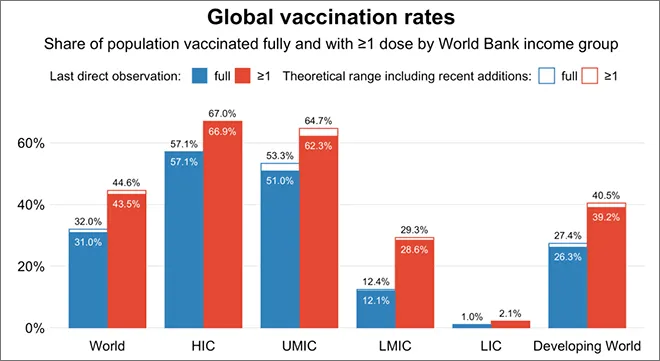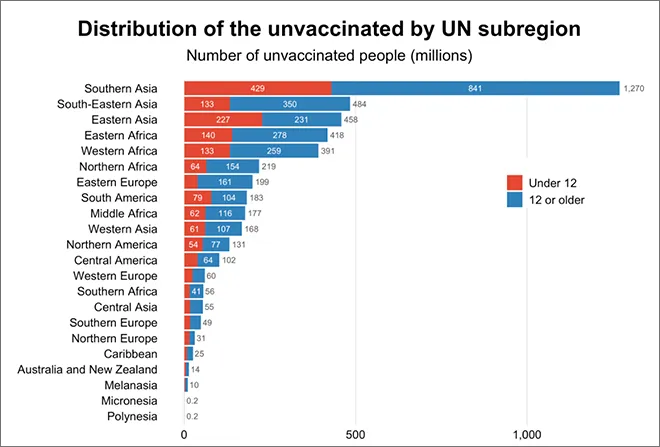
High-income and upper-middle-income countries of the world have already fully vaccinated more than 50 percent of their overall population; meanwhile, low-income countries are still struggling at 1-percent levels of full vaccination coverage (see Figure 1). Even the lower-middle income countries have managed to fully vaccinate just over 12 percent of their population—an average pulled up substantially by the over-14-percent coverage that India has achieved, somewhat distorting the overall situation due to its high population.
Figure 1: Income Disparities in the Global Vaccination Effort
 Source: https://pandem-ic.com/
Source: https://pandem-ic.com/
In this context, the Quad Vaccine Partnership announced in March 2021 assumes greater significance. The partnership’s stated goal is to expand safe and effective COVID-19 vaccine manufacturing for the Indo-Pacific region in close coordination with multilateral mechanisms including WHO and COVAX. Leveraging India’s manufacturing capacity, the idea is to produce at least 1 billion doses of COVID-19 vaccines by the end of 2022. Japan, in parallel, is to provide soft loans to expand manufacturing capacity in India, and Australia will give “last-mile” delivery support with a focus on Southeast Asia, along with financial support for the provision of vaccines. The Quad plans include supporting countries with vaccine readiness and delivery, vaccine procurement, health workforce preparedness, responses to vaccine misinformation, community engagement, immunisation capacity, and related interventions.
The manufacturing hub of Quad’s ambitious vaccine partnership, i.e. India, was already exporting or distributing a substantial proportion of all vaccines manufactured, to the rest of the world at the time of the announcement. However, India’s vaccine diplomacy efforts, which largely followed its Neighbourhood First policy—along with its exports to the COVAX facility in line with the contractual obligations of the Serum Institute—were short-lived as the country was soon overwhelmed by a devastating second wave of infections and deaths, leading to a focus on domestic vaccination. India’s deadly wave in April 2021, and the export disruption it caused, created a vaccine supply vacuum in the region, and the following months saw many countries depending on China for their supplies. India’s initial vaccine diplomacy effort was a high-stakes bet on the possibility of there being no second wave in the immediate future, based on the available information on high seroprevalence and low case numbers. Unfortunately, that was not to be the case.
The Quad plans include supporting countries with vaccine readiness and delivery, vaccine procurement, health workforce preparedness, responses to vaccine misinformation, community engagement, immunisation capacity, and related interventions.
As of now, India still has enormous production capacity; the problem during the second wave was that the need had overwhelmed the production capacity then online. Capacity has since been expanded on a war footing, and more possible vaccine candidates are coming into play almost every month. At the same time, the supply requirements are enormous. Even when exports are ceased and all the vaccines produced are used for its own population, India has fully vaccinated only under 15 percent of its population, and has given one dose to 44 percent of the population. Globally, India’s share is only about 13.5 percent of all COVID-19 vaccinations even as it is home to 18 percent of the world population. At the time of writing, nearly 6 billion doses of the COVID-19 vaccine have been administered across the globe, and there is a clear shortage.
In order to achieve the target of making available 1 billion vaccine doses by the end of 2022, the primary challenge for the Quad Vaccine Partnership in the Indo-Pacific will be to strike a balance between India’s domestic requirements and those of other countries in the region. Even at the beginning of the devastating second wave, India had shown admirable political will to continue exporting vaccines and take a considerable political risk domestically. As most parts of the country still have low vaccination coverage, freeing up supplies for the rest of the world will not be easy. In an unexpected turn of events, India made an announcement on 20 September that vaccine exports will resume in the next quarter. However, there is bound to be strong pushback from the states and civil society. With competing vaccine candidates getting emergency approvals, some even approved for use among children, getting contracts drawn up with companies holding significant manufacturing capacity may prove to be a challenge. India’s under-18 population alone is around 400 million.
To achieve the target of making available 1 billion vaccine doses by the end of 2022, the primary challenge for the Quad Vaccine Partnership in the Indo-Pacific will be to strike a balance between India’s domestic requirements and those of other countries in the region.
The Quad Vaccine Partnership’s manufacturing plans revolve around the Johnson and Johnson single-dose COVID-19 vaccine, which obtained emergency-use approval in August 2021. No delivery timeline has been announced yet. Because of the uncertainties involved, the Quad’s vaccine diplomacy plans need to go beyond efforts to ensure supply, to include helping countries with the challenges of conducting large vaccination drives in low-income settings. Platforms of cross-learning can be established and along with manufacturing of vaccines, this could be an equally important contribution that India as a Quad partner can make to the world. By making the COWIN software open-source, India has announced that it is willing to actively share its experience with other nations, and the Quad can be an effective platform for catalysing an exchange of such solutions.
Figure 2: The Unvaccinated in the world
 Source: https://pandem-ic.com/
Source: https://pandem-ic.com/
As Figure 2 shows, the Indo-Pacific region has the largest unvaccinated population in the world, and any effort to ensure vaccine coverage becomes a moral imperative. To counterbalance China’s hegemonic presence and expansionism through its aggressive health diplomacy efforts despite the
questionable efficacy of its vaccines, the Quad partners will have to come up with a healthcare equivalent of the Malabar exercise in the short term, to help ensure COVID-19 vaccine security in the Indo-Pacific, focusing on both quantity as well as quality. There is a vacuum in the region being filled up largely by Chinese supplies. In the coming months, Quad partners will need to move quickly, and leverage each other’s strengths to ensure mass inoculation in the region. A starting point could be a stocktaking of the progress made over the six months since the launch of the Quad Vaccine Partnership.
This piece is part of ORF’s Special Report No. 161,
The Rise and Rise of the ‘Quad’: Setting an Agenda for India | ORF (orfonline.org)
The views expressed above belong to the author(s). ORF research and analyses now available on Telegram! Click here to access our curated content — blogs, longforms and interviews.



 High-income and upper-middle-income countries of the world have already fully vaccinated more than 50 percent of their overall population; meanwhile, low-income countries are still struggling at 1-percent levels of full vaccination coverage (see Figure 1). Even the lower-middle income countries have managed to fully vaccinate just over 12 percent of their population—an average pulled up substantially by the over-14-percent coverage that India has achieved, somewhat distorting the overall situation due to its high population.
Figure 1: Income Disparities in the Global Vaccination Effort
High-income and upper-middle-income countries of the world have already fully vaccinated more than 50 percent of their overall population; meanwhile, low-income countries are still struggling at 1-percent levels of full vaccination coverage (see Figure 1). Even the lower-middle income countries have managed to fully vaccinate just over 12 percent of their population—an average pulled up substantially by the over-14-percent coverage that India has achieved, somewhat distorting the overall situation due to its high population.
Figure 1: Income Disparities in the Global Vaccination Effort


 PREV
PREV


